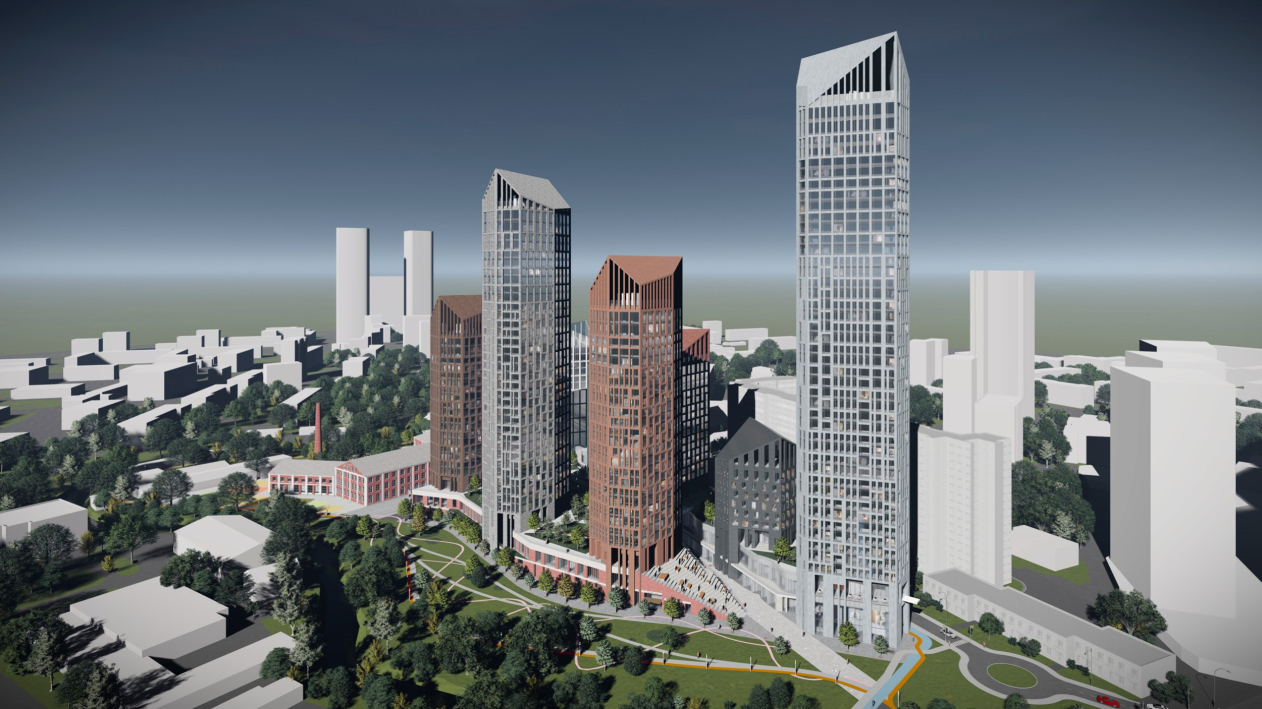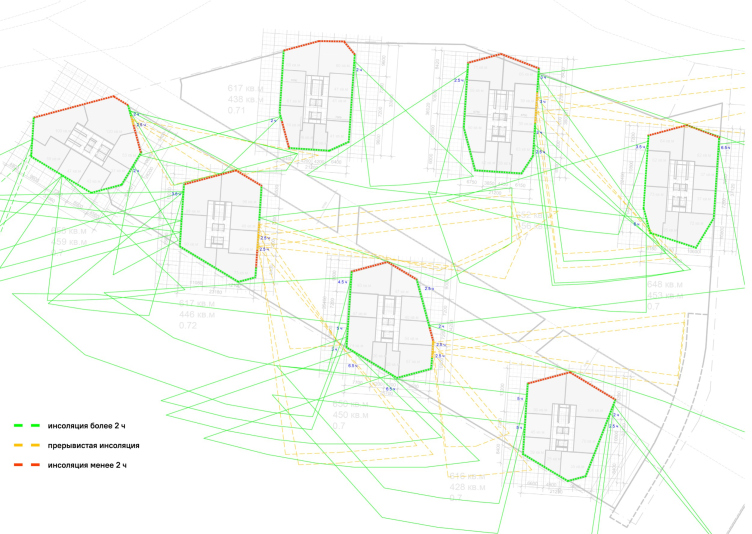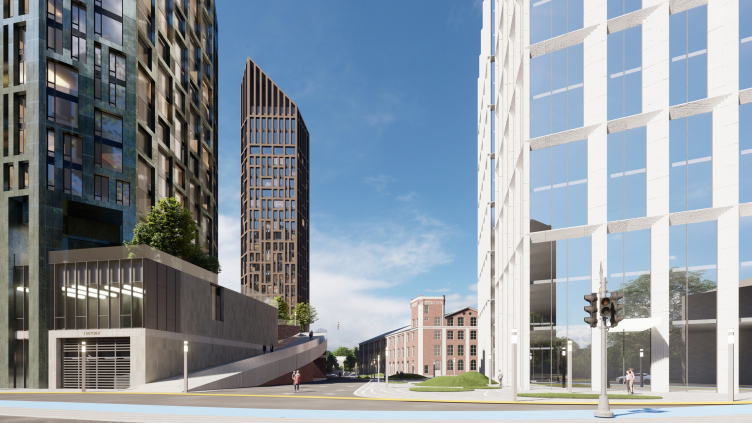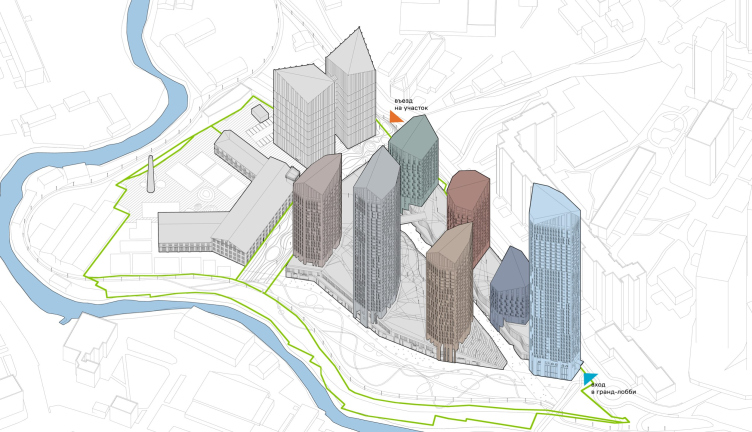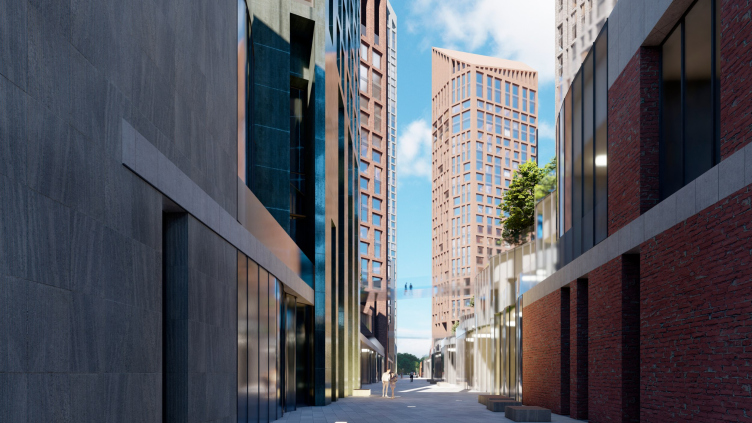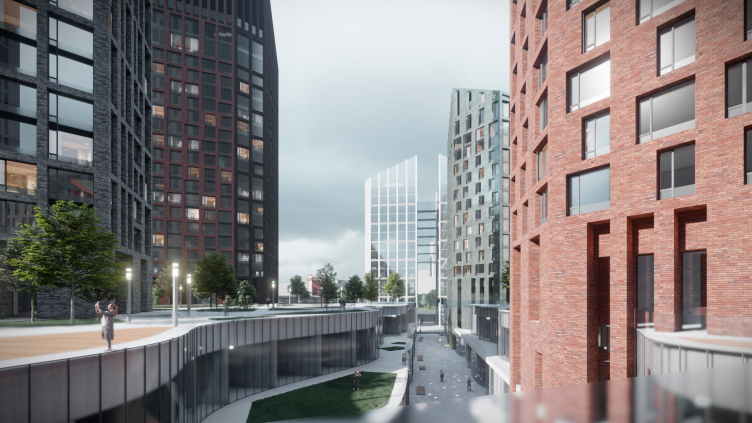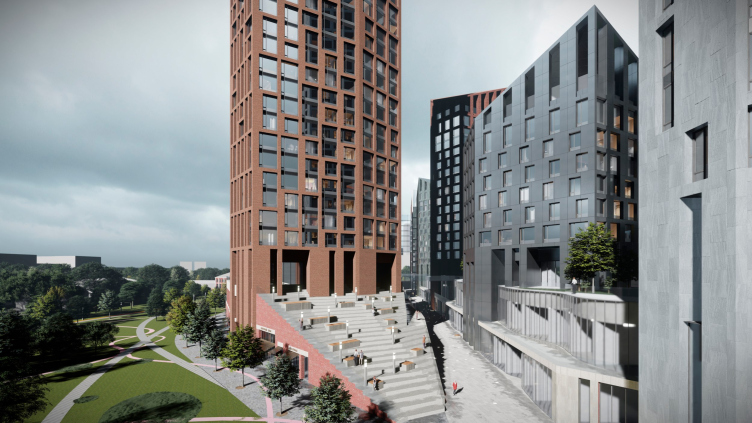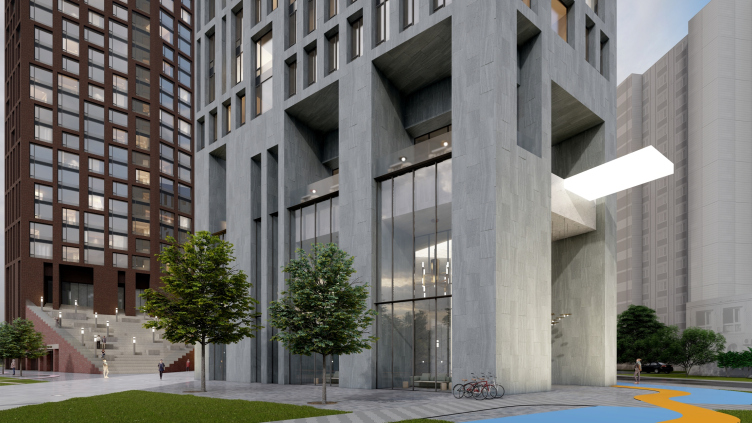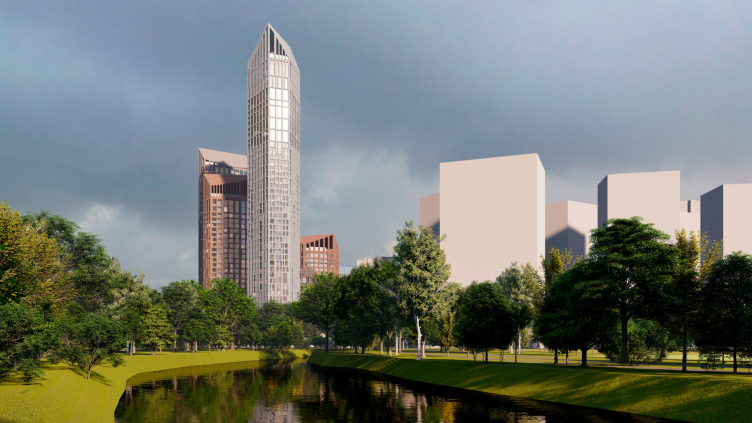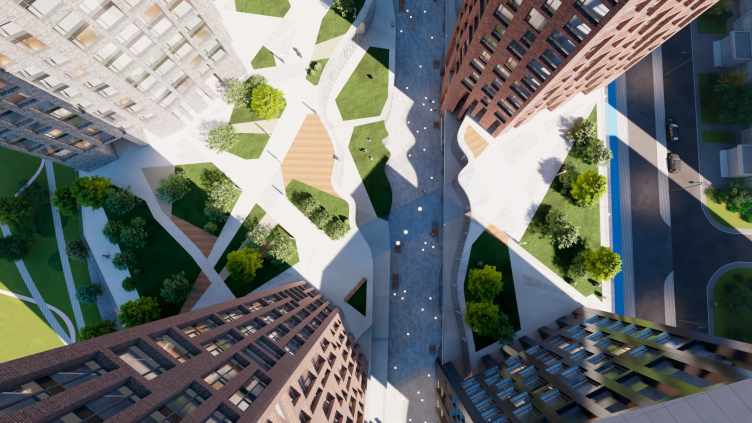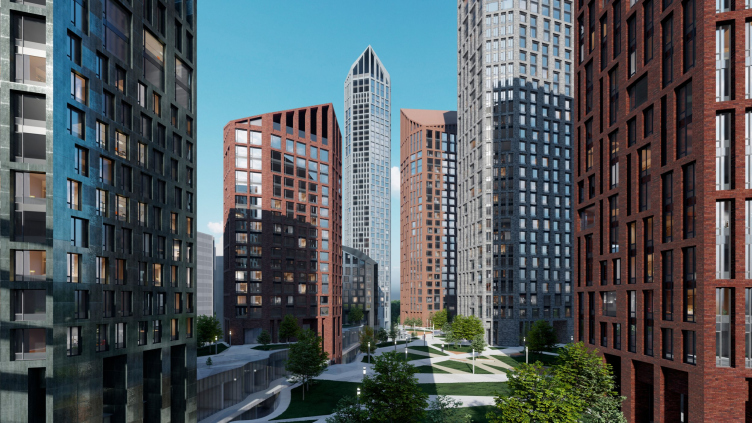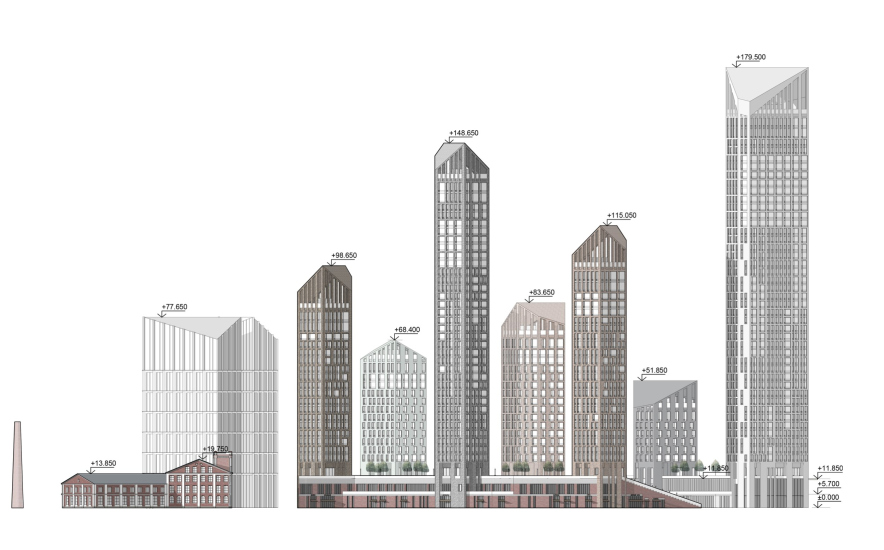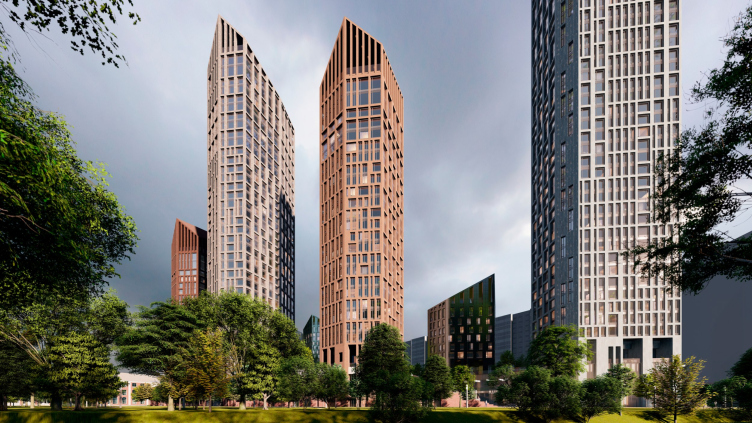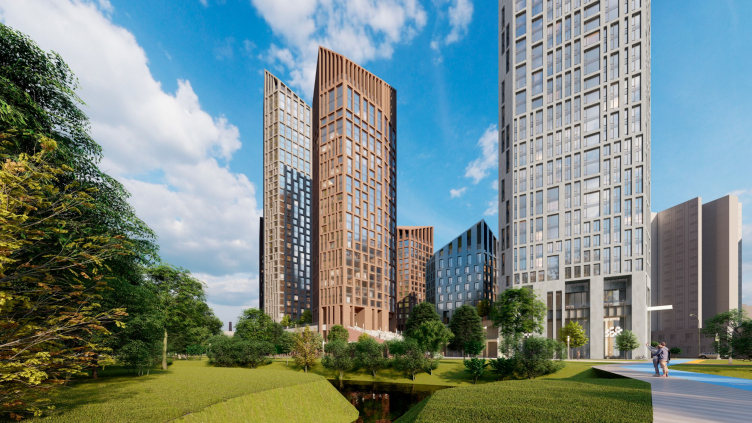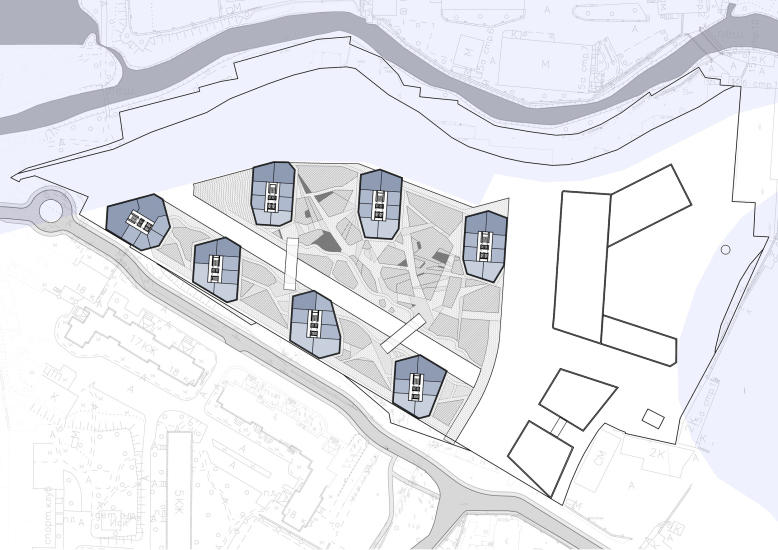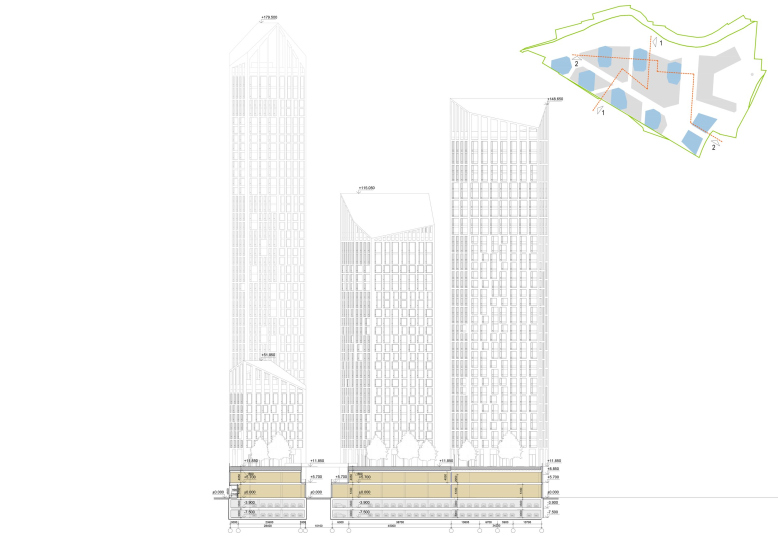The Yauza River is the largest of the small rivers in Moscow, and its banks have recently become the focus of attention for urban authorities and improvement projects. Parks are already scattered along almost the entire length of the river, and now, if different parts are to be connected, it has the potential to turn into a “super-park”, which is undoubtedly a positive factor for nearby residents. Along the Yauza, like almost any river, there are industrial zones, and this combination of water, parks, and industrial zones adds up to a simple equation – a few housing complexes have already appeared on the banks of the river, and more will appear in the future.
The exact location of the proposed residential complex is not disclosed, but it is known to be a high-rise one, located on the territory of a former factory, one of whose brick buildings will be preserved and converted into a school. It also borders the Yauza River, which encircles its territory on two sides in a whimsical loop, providing ample space for a fairly extensive promenade; on the right and left are two parks – a very convenient location indeed!
The housing complex on the Yauza River
Copyright: © Studio 44
“Studio 44” led by Nikita Yavein was invited to work on the concept for this territory. The company is very well-known and operates not only in St. Petersburg but throughout the country; their project, geographically most close to the capital, is the Primakov School. When it comes to Moscow, however, the architects have designed relatively few big projects here, if any, and what we have before us is a little bit of a premiere.
This project is Studio 44’s first experience with high-rise construction in Moscow. One of the client’s requirements was to find a non-trivial image of the skyscraper, different from other Moscow projects.
Surprisingly, the silhouette was largely determined by insolation: in order to “capture” more sunlight, we had to cut off the corners of the rectangular volumes. Another wish of the client was to use pitched roofs. This is how the asymmetrical faceted outline of the top was created, which emphasizes the brick-industrial style of the area.
Thus, simple boxes were transformed into a multidimensional, complex volume of buildings grouped around a central green recreation area.
Surprisingly, the silhouette was largely determined by insolation: in order to “capture” more sunlight, we had to cut off the corners of the rectangular volumes. Another wish of the client was to use pitched roofs. This is how the asymmetrical faceted outline of the top was created, which emphasizes the brick-industrial style of the area.
Thus, simple boxes were transformed into a multidimensional, complex volume of buildings grouped around a central green recreation area.
The insolation development. The housing complex on the Yauza River
Copyright: © Studio 44
So! The territory covering an area of 5.1 hectares, on one side, is integrated into the developing part of the city, while on the other side it is partially isolated by the contour of the river, neighboring parks, and a distance of 300-600 meters from the busy urban highways.
Currently, the territory of the future complex is occupied by a former factory, where there already exists a transverse boulevard dividing the site from north to south; its width in the project is 25 meters. To the east of the boulevard, the architects have placed two towers of a business center and a school with a kindergarten: they plan to accommodate them in one of the preserved brick buildings, adding an extra wing to it. Here, we will see a peculiar contrast between the “crystalline” glass towers and a brick industrial building adapted for the school. We recently mentioned that placing a school in a former industrial building happened in Moscow for the first time in the “Republic” housing complex, and almost immediately, a second such case appeared here. And it is certainly not the first time for Nikita Yavein to place classrooms in historical buildings, it is enough to remember Eifman Dance Academy in St. Petersburg.
Center: the complex of schools and preschools. Right: business center. Left: residential buildings. The housing complex on the Yauza River
Copyright: © Studio 44
A random fun fact: next to the school, they will preserve one of the chimneys of the former factory.
The western, larger part is occupied by residential towers resting on stylobates. Across the territory, a collector passes, over which construction is prohibited – together they form a spatial cross, the intersection of future vehicle-free pedestrian arteries, and unite the complex, stringing it onto the urban axes.
The housing complex on the Yauza River
Copyright: © Studio 44
All these connections at the lower levels are organized into a coherent system of urban spaces built according to modern rules. The height of the stylobates is 11.8 meters, which is a three-story medium-sized building, with two floors inside allocated for shops and other “commercial premises of flexible purpose”. To prevent the pedestrian street over the collector from turning into a gorge, the architects vary its width, making the contours of the floors wavy, and for pedestrian permeability, they throw two pedestrian bridges over the street, connecting the stylobates. Such bridges, besides being useful from the purely utilitarian standpoint, always look pretty spectacular.
The housing complex on the Yauza River
Copyright: © Studio 44
The housing complex on the Yauza River
Copyright: © Studio 44
By the way, the bridges resonate with a large glass bridge – suspended floors that connect the two towers of the business center, opening up a boundless perspective view at the lower part – a visual axis.
View to the pedestrian street at the roof level of the stylobate. The business center in the background. The housing complex on the Yauza River
Copyright: © Studio 44
A complex of such scale is inconceivable without visual axes: the architects have considered several perspectives, including views from the city to the business center; they suggest slightly adjusting the lines of the existing boulevard to better integrate the intersection of the new complex into the spatial structure of the surroundings. And this solution is undoubtedly correct – when each new development seeks not to overcrowd but to structure the urban fabric, the latter becomes a lot more coherent. Here one can easily recognize the St. Petersburg origin of the architects and their professional approach.
On the side of the park, which is situated closer to the metro station – a 10-minute walk across the bridge over the Yauza River – the architects place the “entrance” square. Here begins the axial street, and to the left of it, the stylobate descends with a triangular amphitheater (which somehow subtly resembles the amphitheater in the Saint Petersburg Joint Staff building, the one at the end of the enfilade).
The housing complex on the Yauza River
Copyright: © Studio 44
On the right side stands the tallest residential tower, 179.5 meters high with 42 floors in it, opening up to the residents with a grand lobby under a flashy illuminated canopy. From here, you can access any of the towers and the roof of the stylobate.
The housing complex on the Yauza River
Copyright: © Studio 44
The housing complex on the Yauza River
Copyright: © Studio 44
The housing complex on the Yauza River
Copyright: © Studio 44
The housing complex on the Yauza River
Copyright: © Studio 44
Walking through the pedestrian street through the residential area – with shops on both sides, which make it a true urban street – we arrive at the business center (likely to seek Chinese tenants as the Chinese center is nearby). Here, too, there’s a city square, more of a business nature, as the architects explain, and here, too, an amphitheater is designed.
While the business center is oriented towards the intersection of the street and the boulevard, the school and kindergarten, on the contrary, require some measure of privacy: the L-shaped historical building in the project receives a new wing, set at an angle, turning the plan into a trapezoid, and the inner courtyard faces the river and is separated from the urban public spaces. This provides children with more tranquility, and the noise of their games is less audible from the other side.
The roof of the stylobate is a private courtyard shared by all the residents. Here, a sufficiently large layer of soil, 1.5 meters, is planned to be placed, along with a network of diagonal pathways.
The housing complex on the Yauza River
Copyright: © Studio 44
The housing complex on the Yauza River
Copyright: © Studio 44
The buildings themselves – towers ranging from 12 to 42 floors – are arranged on the stylobate in a checkerboard pattern, avoiding the “window-to-window” view and maximizing sunlight exposure to each other. Three towers are placed on one side, with five, starting from the tallest, on the other. The taller towers – closer to the river and the northern part – enjoy more views (in the previous project by other authors for the same location, everything was the opposite). The varying heights create a diverse silhouette.
Particularly impressive are the rooftops cut at different angles. They echo the faceted contours of the towers, but sharper and more radical in profile. The architects transform the towers into “pencils” – not blunt, but sharpened, which looks quite refreshing considering the abundance of towers with flat tops that have appeared in Moscow in recent years. It’s evident that for the architects from St. Petersburg, working with the client’s request for pitched roofs, as was voiced here, is quite a habitual thing to do. One might recall here the project by Studio 44 for the historic center of Kaliningrad, which, albeit completely different, also interprets the theme of pitched roofs.
It looks more like the result of a new search. And it’s worth noting that there’s nothing traditional here, no enlarged repetition of historical buildings – it’s not felt at all. The asymmetrical, high protrusions almost seem daringly “cut off” at the top. This is quite an original move, and by no means conservative. The entire silhouette takes on a contour similar not so much to the typical Moscow “cluster of towers”, but to the Moscow City, and not even necessarily that specific business center, but rather the generalized downtown skyscraper area. The Moscow City complex is known for the desire of each tower to assert itself so densely that they compete with each other, resulting in a distinctive silhouette. In this case, however, it’s not quite the same: the towers vary in size, their heights differ, yet the protrusions, despite their diversity, are unified by one technique. However, the silhouette typology is precisely that.
It’s also interesting that in some places, the slopes are arranged to protrude outward: the silhouettes of the groups diverge, expanding outward – which gives uniqueness to the shapes of the roofs, which in themselves, one would think, should adhere to tradition, but in this case, they don’t seem to.
The housing complex on the Yauza River
Copyright: © Studio 44
Moreover, here one can see a kind of light deconstruction of the diverging “Kremlin battlements”, a subtle trolling of Moscow by Saint Petersburg.
The protrusions not only form original attics and allow the architects to mask the technical floors – it’s possible that these “pergolas” could host the terraces for upper-floor apartments, which also feature higher ceilings – 4.2 meters instead of the regular 3.3 meters.
The uniqueness of the architectural solution is also enhanced by the facade grid. It is designed deliberately irregularly, resembling densely packed Tetris figures. The façade grid can also be compared to a characteristic modernist technique – if you look at it closely, you will see that a similar pattern was used in the buildings of the Optics House next to the Cosmos Hotel and the Institute of Mechanical Engineering on Zvezdny Boulevard (now the Nix store); both were built in the 1970s, and the pattern is based on alternating sequentially inverted cells: a strip at the bottom, a strip at the top.
In this case, however, the technique is noticeably more sophisticated – I would say, if in the 1970s it was used arithmetically, now it’s used algebraically: there are more variations, and the compositions are harder to predict, not only because they are defined by the artistic will of their authors but also by the orientation of the facades, by insolation, and by the viewing angles.
The housing complex on the Yauza River
Copyright: © Studio 44
The housing complex on the Yauza River
Copyright: © Studio 44
To some extent, this pattern can be seen as a depiction of a “downward flow” of apartments packed inside a large building. The apartments here, by the way, come in five types with subtypes, from studios to four-room apartments of 95 square meters – predominately two and three-room ones.
The color of the facades, on the other hand, falls more into the Moscow trend of recent years – a love for brick in natural brownish, grayish, and greenish shades. Equally, it resonates with Studio 44’s recent work in St. Petersburg – a residential complex in the territory of Mytny Dvor; only there, it’s subtly emerald green/ceramic, while here it’s aluminum, composite, or fiber cement. The shades allow distinguishing the buildings, but the commonality of the restrained palette gives the residential part integrity and distinction from the contrasting buildings of the business center and school.
The housing complex on the Yauza River
Copyright: © Studio 44
The housing complex on the Yauza River
Copyright: © Studio 44
So, the “Moscow” scale and the format of towers relevant to the capital, a demand for original form and simultaneously pitched roofs, requirements for insolation and views, plus the St. Petersburg view on things and Studio 44’s interest in avant-garde solutions, all together have resulted in a cohesive complex with developed internal space, which, when and if realized – currently, the project is in the concept stage – will be interesting to visit. And the complex is quite capable of revitalizing the silhouette of this part of the city, which is now actively growing.

